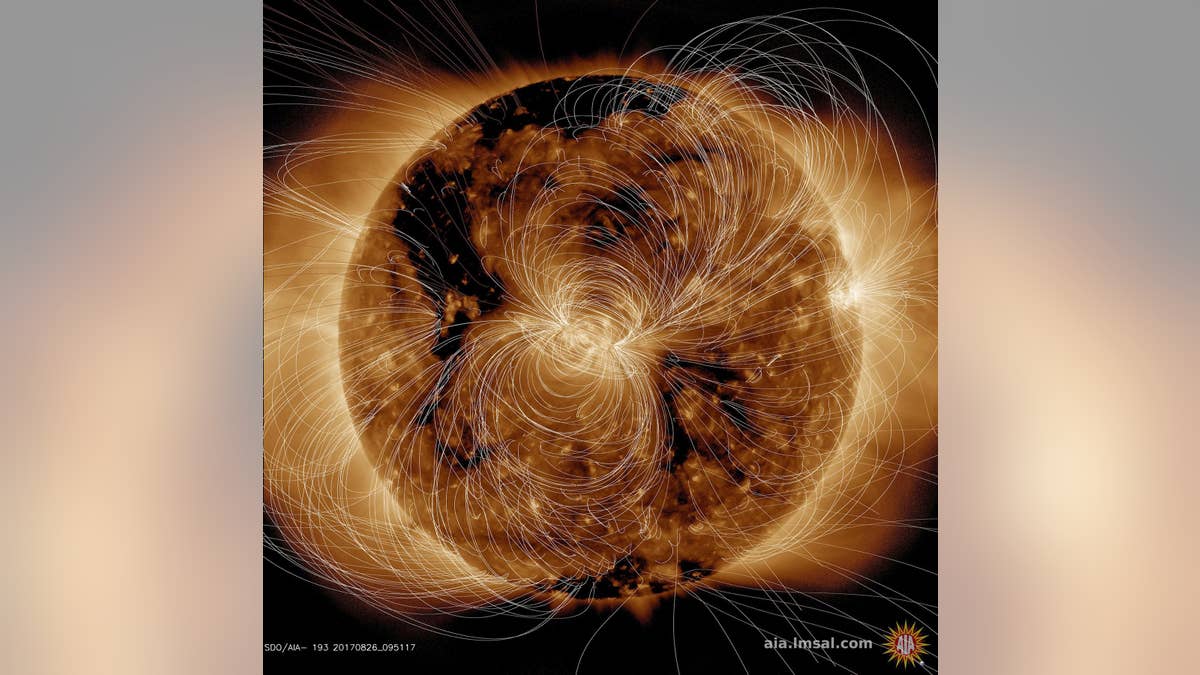
(Credit: NASA/GSFC/Solar Dynamics Observatory)
NASA has unveiled an incredible image of the Sun "exploding," but fear not — this violent reaction happens on a near constant basis and is nothing to worry about, experts say.
The above image, taken on Aug. 10, 2018 of the Sun's magnetic field, is formed from computer models to capture snapshots of the star's violent nuclear fusion reactions and the Sun's magnetic view.
"The bright active region right at the central area of the Sun clearly shows a concentration of field lines, as well as the small active region at the Sun's right edge, but to a lesser extent," NASA wrote in a short statement accompanying the photo. "Magnetism drives the dynamic activity near the Sun's surface."
NASA'S PARKER SOLAR PROBE IS HEADED TO THE SUN. SO, WHAT'S NEXT?
The white lines represent an electromagnetic eruption, stemming from a high-energy interaction between the particles that make up the Sun's magnetic field and its plasma, according to LiveScience.
The energy released from the Sun, seen in the above image, is partially responsible for events such as solar winds and other types of space weather.
The Sun, which at its core is a blistering 27 million degrees Farenheit, is comprised of violent nuclear fusion reactions, molten plasma, radiation and electromagnetic energy.
NASA hopes to be able to learn more about the Sun and gather images like this, following the recent launch of its Parker Solar Probe, designed to "touch the Sun."
The $1.5 billion mission will take humanity closer to the Sun than ever before. Parker will be the first spacecraft to fly through the Sun’s corona, the outermost part of the star’s atmosphere.
Parker will face “brutal” heat and radiation during an epic journey that will take it to within 3.8 million miles of the Sun’s surface, according to the space agency. This is seven times closer than the previous closest spacecraft, Helios 2, which came within 27 million miles of the Sun in 1976.
MEGA BLACK HOLE COULD DEVOUR THE SUN
Parker must withstand heat of nearly 2,500 degrees Fahrenheit to complete its audacious mission. To achieve this, the probe will be protected by a special 4.5-inch-thick carbon-composite shield. Safe inside the spacecraft, however, the probe’s payload will be operating at room temperature.
The Sun’s corona, which can be seen during a total solar eclipse, is usually hidden by the bright light of the star’s surface. The probe, named after pioneering solar physicist Dr. Eugene Parker, will provide a wealth of invaluable data.
The Parker Solar Probe is expected to reach the Sun in November.
Fox News' James Rogers contributed to this report. Follow Chris Ciaccia on Twitter @Chris_Ciaccia




















